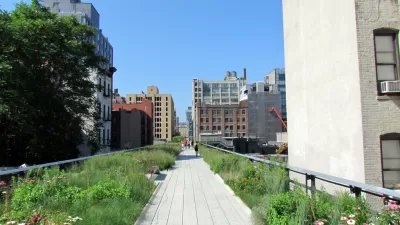A recent article in Salon cites the High Line as perhaps the most conspicuous example of how municipal governments are subsidizing wealthy corporate or private interests while many citizens continue to suffer low wages and benefits.

In explaining some of the unacknowledged costs and causes of gentrification, Sally Kohn cites the example of a new residential building near the High Line in New York City: “In a glittering new building at 540 West 28th Street, a 700-square-foot one-bedroom apartment just sold for $1.3 million. Manuel Matos, a concierge in the building, makes just $12 an hour and has no health insurance. Matos also lives in a one-bedroom apartment — one he shares with his parents almost an hour’s commute away from work.”
Kohn’s larger point is that cities are subsidizing the wealthy while leaving low income residents in the lurch. “Cities that didn’t have enough money to spend on parks in poor neighborhoods or pensions for public employees suddenly have enough money to subsidize corporate office parks and stadiums,” writes Kohn, who also cites a New York Times article that such deals often do not produce the benefits they optimistically hoped for.
A final, provocative point by Kohn: “The not-so-hidden message of gentrification is that there is always plenty of money to go around, even public money, for the whims of the rich.”
FULL STORY: Gentrification’s quiet tragedy: How sweetheart deals are brutalizing the public

Maui's Vacation Rental Debate Turns Ugly
Verbal attacks, misinformation campaigns and fistfights plague a high-stakes debate to convert thousands of vacation rentals into long-term housing.

Planetizen Federal Action Tracker
A weekly monitor of how Trump’s orders and actions are impacting planners and planning in America.

Chicago’s Ghost Rails
Just beneath the surface of the modern city lie the remnants of its expansive early 20th-century streetcar system.

Bend, Oregon Zoning Reforms Prioritize Small-Scale Housing
The city altered its zoning code to allow multi-family housing and eliminated parking mandates citywide.

Amtrak Cutting Jobs, Funding to High-Speed Rail
The agency plans to cut 10 percent of its workforce and has confirmed it will not fund new high-speed rail projects.

LA Denies Basic Services to Unhoused Residents
The city has repeatedly failed to respond to requests for trash pickup at encampment sites, and eliminated a program that provided mobile showers and toilets.
Urban Design for Planners 1: Software Tools
This six-course series explores essential urban design concepts using open source software and equips planners with the tools they need to participate fully in the urban design process.
Planning for Universal Design
Learn the tools for implementing Universal Design in planning regulations.
planning NEXT
Appalachian Highlands Housing Partners
Mpact (founded as Rail~Volution)
City of Camden Redevelopment Agency
City of Astoria
City of Portland
City of Laramie




























